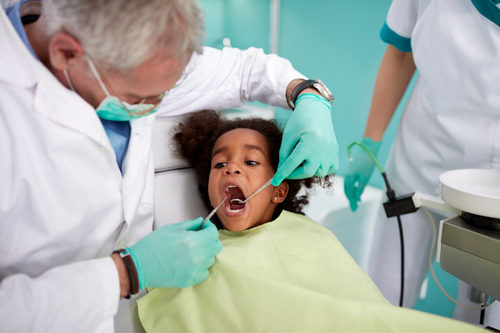Has it been a long time since your child received a dental cleaning? Brushing your teeth and gums regularly is necessary but insufficient to keep them healthy and robust. Children should begin adopting good dental practices as early as possible. During a wellness visit, the dentist can assess the child’s health and recommend necessary treatment measures.
A typical kid’s dental cleaning
A routine visit to the dentist often takes less than an hour, but the benefits can be long-term. The dental team begins by evaluating the patient’s oral health history before taking X-rays of the child’s mouth. Next, a hygienist will scrape any plaque or other buildup on the teeth. This is followed by cleaning all sides of each tooth with an ultrasonic dental tool. The hygienist flosses and then polishes the patient’s teeth. After the cleaning, the dentist checks the X-rays for cavities and other issues before inspecting the child’s teeth and gums.
When to start
Parents should plan an appointment with their child’s dentist soon after they obtain their first tooth. Teeth typically appear when the infant is six months old. Dentists advise parents to bring their children in around six months later. For the first few years, appointments for teeth cleaning for kids dental cleanings will be limited. Instead, the dentist will look for indications of difficulty and potential problems. The dentist will follow up to ensure the child’s parents are brushing and caring for their teeth.
Visit frequency
From the first visit, children should visit the dentist every six months for a dental cleaning. This practice should continue throughout adulthood and the rest of the person’s life. Patients with gum disease or prone to cavities may require sessions between wellness checkups.
What to expect from a pediatric dental cleaning
Dental cleaning is the third and final stage in a routine dental examination. The first step is a comprehensive dental examination, which may or may not include dental x-rays. If the dentist discovers any dental issues at this point, they will propose a remedial operation. If your child’s teeth are in good condition, the dentist will:
- Scrub their teeth with a mild but gritty toothpaste and a soft toothbrush or cloth.
- Gently floss between teeth.
- Rinse your teeth.
- Use sealant or fluoride to safeguard their teeth.
Pediatric dentists will go to great lengths to ensure the operation is as painless as possible.
Benefits of pediatric dental cleaning
Teeth cleaning is part of a package deal that includes a dental exam. The preventative treatment comes with the following benefits:
1. The dentist gets to evaluate the oral habits of the child and caregiver
As the dentist examines the child’s teeth, they offer suggestions and feedback to their caregivers. They will educate their parents on the need for a healthy diet and proper oral hygiene and how to pass this information on to their children. The dentist will offer advice and guidance on developmental milestones and at-home dental examinations.
2. The dentist gets to monitor the growth and development of the child’s mouth
X-rays are occasionally taken during the exam phase of a standard dental visit. A pediatric dentist uses these photos to track the development of the child’s jaws and teeth. X-rays also provide information that dentists use to identify orthodontic issues in their early stages.
3. Dental cleaning prevents plaque and tartar accumulation
The surfaces of some teeth are difficult to access due to their position in the mouth. Children with orthodontic difficulties may also struggle to clean the hard-to-reach nooks that form between misaligned teeth.
Pediatric dentists clean all surfaces of each tooth to avoid plaque and tartar buildup. This prevents dental disorders such as cavities and gum disease.
4. Routine dental cleaning comes with cost savings
Dental cleanings are less expensive than treatments for cavities, missing teeth, and gum disease. Furthermore, a child who visits the dentist regularly is more likely to maintain the habit in later life.
This dental habit goes a long way toward maintaining good oral health for life. Teeth that require only a few dental operations are inexpensive to own.







